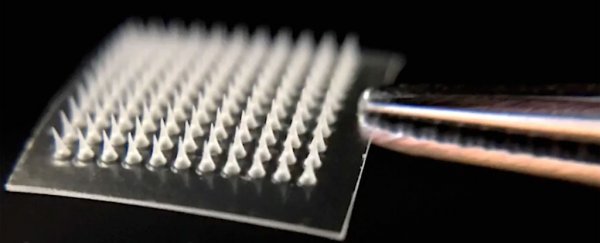A skin patch that effectively melts excess body fat wherever you decide to apply it sounds too good to be true, but this thing actually exists, thanks to new research.
The medicated patch uses an array of skin-piercing microneedles to deliver nanoparticles of drugs to the body, and while it hasn't yet been tested on humans, trials with mice show it reduces fat by as much as 20 percent in treated areas.
Developed by researchers at Columbia University and the University of North Carolina, the skin patch doesn't just hold promise (and potential riches) for the cosmetics industry – it could one day help us to fight conditions like obesity and diabetes.
The way it works is to do with how our bodies store fat, which largely comes down to two kinds of fat cells: white fat and brown fat.
Brown fat is often thought of as 'good fat' because it readily breaks down and produces heat – which is why newborns have a lot of it, given they need help regulating their body temperature.
Unfortunately for grown-ups, we don't have as much brown fat, and are instead saddled with ungainly deposits of white fat around our bodies, which is used for long-term energy storage, but not so easily burned.
In recent years, there's been a huge amount of scientific effort focussed around bridging the gap between these two kinds of fat – or, more accurately, learning how to convert energy-storing white fat into energy-burning brown fat.
A number of studies have shown success in triggering the transformation – sometimes called browning – but from a health care perspective, there's a problem.
"There are several clinically available drugs that promote browning, but all must be given as pills or injections," says one of the team, pathologist Li Qiang from Columbia University.
"This exposes the whole body to the drugs, which can lead to side effects such as stomach upset, weight gain, and bone fractures. Our skin patch appears to alleviate these complications by delivering most drugs directly to fat tissue."
This is possible due to the patch's grid of microscopic needles, which deliver browning chemicals under the skin wherever white fat is being stored.
In their study, the researchers used two different browning drugs, rosiglitazone (aka Avandia) and a chemical called CL316243, which has previously been shown to brown white fat in mice.
First up, the drugs are encased in nanoparticles, each measuring about 250 nanometres (nm) in diameter – for reference, a human hair is approximately 100,000 nm wide, so we're talking really, really small.
These nanoparticles are then deployed in the patch, and when the microneedles painlessly pierce the skin, the nanoparticles are delivered into the tissue directly under the patch, where they dissolve.
"The nanoparticles were designed to effectively hold the drug and then gradually collapse, releasing it into nearby tissue in a sustained way instead of spreading the drug throughout the body quickly," explains one of the researchers, biomedical engineer Zhen Gu.
In experiments with obese mice, patches were applied every three days for a total of four weeks. Treated mice had two patches applied on different sides of their bodies: one containing a browning drug, and the other containing empty nanoparticles.
The results showed that the patches containing either rosiglitazone or CL316243 produced a 20 percent reduction in fat on the animals' treated side (compared to the empty nanoparticles patch).
They also showed lower fasting blood glucose levels than control animals who were also only given patches containing no browning drugs.
In lean mice the treatment also offered benefits, increasing animals' oxygen consumption compared to untreated controls.
Of course, there's no guarantee humans wearing the patch would see the same results, but it's another promising step forward as scientists gradually uncover the mechanisms that control brown and white fat production.
The team are currently researching which drugs, or which combination of drugs, might work best to enable this kind of localised browning – as it's possible the right chemical might even be able to improve on the already impressive 20 percent fat reduction they've seen so far.
"Many people will no doubt be excited to learn that we may be able to offer a noninvasive alternative to liposuction for reducing love handles," says Qiang.
"What's much more important is that our patch may provide a safe and effective means of treating obesity and related metabolic disorders such as diabetes."
While at present there are no firm plans to release the patch for use by people, it's quite possible that something like this might become available in the future once a lot more research and safety tests are completed.
Until that fateful day, there's always fish oil.
The findings are reported in ACS Nano.
